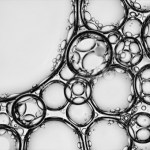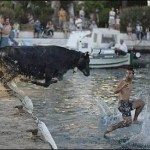water
This is how.
-----------
This image was provided by Ted Kinsman for Photo Synthesis.
There's an issue of Eos sitting on my desk at work with a front-page article about how to manage outreach. Earth scientists know stuff that's important - this week's huge earthquakes (covered all over the geoblogosphere) are just one example. Water's another. And climate. And volcanoes. And landslides. And... well, you get the picture. So outreach is important.
But the best outreach might be the stuff that goes on every day in schools. My kid's lucky - he lives in a college town, with all sorts of students and professors providing opportunities to learn cool stuff. But a lot of kids don't…
Anne Jefferson, a hydro-geomorpho-climate geologist at UNC-Charlotte, has officially joined Highly Allochthonous as Chris Rowan's co-blogger. Anne's been unofficially co-blogging there for a while, but it's great to see her role made more official. And it's especially great to see someone with expertise in water and surface processes on Sb.
(Anne and I are also working together on a survey about women geoscientists and blogs - if you haven't taken it, please check it out.)
Americans know that the Ogallala Aquifer is important, and declining. This is much more of an issue in India, Satellites Unlock Secret To Northern India's Vanishing Water:
Using satellite data, UC Irvine and NASA hydrologists have found that groundwater beneath northern India has been receding by as much as 1 foot per year over the past decade - and they believe human consumption is almost entirely to blame.
Here's a map of the population density of India by district:
And now a map of the change in the levels of groundwater (red = decline, blue = increase):
The original letter to Nature,…
Aesop's fable "The Crow and the Pitcher" has been confirmed in a wonderful experiment. In the classic tale, a thirsty crow uses stones to raise the level of water in a pitcher until it rises within reach of its beak. This is no mere fiction - rooks, close relatives of crows, have the brains to actually do this.
The aptly named Chris Bird, along with Nathan Emery, gave four captive rooks (Cook, Fry, Connelly and Monroe) a chance to reach a small worm floating in a cylinder of water, with nothing but a small pile of stones sitting on the side. All of them solved the task, and Cook and Fry…
tags: potable water, safe drinking water, LifeSaver Bottle, streaming video
Too much of the world lacks access to clean drinking water. In this video, engineer Michael Pritchard did something about it -- inventing the portable Lifesaver filter, which can make the most revolting water drinkable in seconds. An amazing demo from TEDGlobal 2009. [10:05]
TEDTalks is a daily video podcast of the best talks and performances from the TED Conference, where the world's leading thinkers and doers give the talk of their lives in 18 minutes.
Sometimes art doesn't need to be complicated. Shawn Knol's simple videos of oil in water capture fascinating patterns reminiscent of dividing cells, budding spores or lava lamps, depending on your mood. His newest, Psycho Bubble (above), was just released a few days ago.
"A lot of people are asking how I did this. It's pretty simple. I just put the camera on its lowest jpeg setting, placed the camera into continuous mode, and locked the shutter down with my wired remote. The oil is being dumped into a tall cylindrical glass, with about a cup of water in it. The whole thing is lit from…
tags: science, physics, boiling water into ice, streaming video
This should go into the category: What scientists do when the boss is out of town: This video shows a couple scientists who are "boiling water into ice." Can you describe how they do this? [5:02]
Water. Too much and you drown, not enough and you die of thirst. Getting it just right is important. But how?
One of the fears associated with global warming is that it could lead to droughts that could lead to wars. There was an essay in Nature in March that argued that those wars don't really happen - that countries trade virtual water when they import food. But is that really the case? Seed has a nice article today about just that. It brings together seven experts on water and international relations to address the question of water and conflict. The consensus, if you can ever get one from…
Simple, but surprisingly charming - and somewhat reminiscent of an ant colony or other biological collective:
Fluid Sculpture (click for larger video) from Charlie Bucket on Vimeo.
Aquasaurus
paint, resin, steel
Jitish Kallat, 2008
At first I thought this piece by Indian artist Jitish Kallat was an oil tanker truck, and that it represented some sort of play on "fossil fuels" (and perhaps the morbidity of the behemoth domestic auto companies). But apparently that was my American bias at work.
It's actually a water tanker, entitled Aquasaurus, and it represents the rapid transformation of urban India:
Aquasaurus is a monumental seven-metre long skeletal sculpture of a water-tanker morphing to become prehistoric creature that personifies the radical transformation of…
This is a post for World Water Day. See more posts about transboundary water at Cr!key Creek.
For the past two years, my intro Earth Science students have been doing a project monitoring one of our local rivers. On the one hand, it's just another stream, small enough for students to safely wade into it with a current meter. On the other... it's our town's water source, and every drop of it is promised at least once, for irrigation, for municipal water supplies, for fish, for electricity, for a treaty between the US and Mexico.
The Florida River (Flor-EE-da, the Spanish word for "flowery") is…
I've been blogging my way throug the redesign of my upper-level general education course, "The Control of Nature," using a course design tutorial from SERC. I've talked about what's gone wrong in the past, about who my students are and what they need from the class, and about my tentative goals for the class. I've been mulling over the problem (and also going back to classes after spring break), and I've finally worked through the next part... the course plan.
When it comes time to put a course together, I've got some bad habits. For instance, when I don't have any good ideas, I start by…
I'm rethinking one of my courses, an upper level general education course called "The Control of Nature." I've been blogging my way through the course redesign process, starting with past problems with the course and with my various practical constraints (class schedule, physical space, student background). I'm using an online tutorial to guide me through the process, and now I'm finally moving towards thinking about the course itself.
Before I actually start redesigning lectures and in-class exercises and assignments, I need to figure out what I want students to be able to do when they get…
I've got a course that (IMO) is broken, and I'm working on fixing it.
I've been teaching a course called "The Control of Nature" (after John McPhee's book) for 16 years, after thinking of the idea on my way home from my first academic job interview. (Yes, that was a bad time to come up with an answer to a question like "what other class could you teach?" No, I didn't get that job.) I've taught it as an intro course for non-majors and as an upper-level interdisciplinary general education class, and I had plans, once, to adapt it for a freshman seminar and for a large-lecture gen ed class. It'…
Cr!key Creek invites bloggers to join him on World Water Day, March 22, and post about water basins and aquifers that cross political boundaries.
Here's what he said:
There are hundreds of water basins and aquifers that straddle our political boundaries, at both international and national levels. Neighbours stick their own straws into the same glass. This has historically led to both conflict and cooperation.
"Over the last 60 years there have been more than 200 international water agreements and only 37 cases of reported violence between states over water."
In the spirit of World Water…
There has been a lot of cool stuff posted while I was getting this blog set up. From my Google Reader shared items:
Exotic rocks. There's an art exhibit in Oakland, California, that includes metamorphic rocks from Maine. Why? Because the schists sound like xylophone keys when they're struck. I knew there was a reason why I liked hitting metamorphic rocks with my hammer...
Fermi paradox meets the timescale. Why haven't we been visited by intelligent life? Well, if we had been visited by intelligent life sometime during Earth's 4.6-billion-year history, odds are that there wasn't any…
Do restaurants and fishmongers frequently mislabel their fish so you think you are eating delicious thermal vent tube worm when you are really just eating pollock?
Why do shore birds run in fright from small lapping waves?
How does Kevin Z manage to trick us into reading his "writing?"
Learn more about these and other fishy tales from our credentialed but unemployable brethren over at Deep Sea News hosting Carnival of the Blue 18.
Some incredible early morning shots of wet insects by German photographer Martin Amm.
Red veined darter
Horsefly
more below the fold
Emerald damselfly
Breakfast
Check out more of his work here
Clearly, neither the man nor the bull below is headed for anything good in their attempt to walk on water,
and for that matter, neither is this poor, bristling cat,
but what about this reptile?
Unbelievably, this lizard actually can walk on water! And without using any surface tension tricks like insects do, either. No, whereas a human puts his foot into the water and sinks, this lizard has a very low mass and a very large surface area on his feet, allowing him to "run" on water as long as he moves quickly enough. For this lizard, that's about 10 miles-per-hour. As opposed to a human, who…


